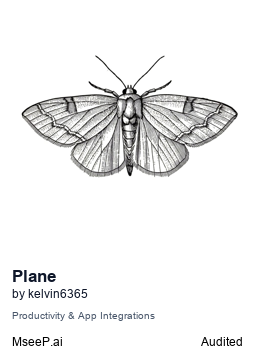About
A Model Context Protocol server that lets large language models interact with Plane.so’s API, enabling creation, update, and retrieval of projects and issues directly from LLM workflows while preserving user control.
Capabilities

Plane MCP Server is a dedicated Model Context Protocol (MCP) service that bridges large‑language models with the Plane project‑management platform. By exposing Plane’s RESTful API through MCP, the server lets assistants such as Claude manipulate projects and issues directly from within a conversational interface. This eliminates the need for developers to write custom API wrappers or build separate UI components, streamlining the integration of project‑management workflows into AI‑powered applications.
The server provides a concise set of tools that mirror common Plane operations: listing projects, retrieving detailed project data, creating and updating issues, and filtering issue lists. Each tool is intentionally lightweight, requiring only the minimal parameters needed for the underlying Plane endpoint. This design keeps prompts simple while still offering full control over project attributes, issue priorities, and other metadata. Because the MCP server runs locally (or on a private host), all API keys and workspace identifiers remain secure, ensuring that sensitive project data is never exposed to the model or third‑party services.
For developers building AI assistants, Plane MCP Server offers several practical advantages. First, it removes the friction of authentication; once the API key and workspace slug are configured in the client settings, the assistant can perform authenticated requests without additional user input. Second, it standardizes project‑management interactions across different LLMs and front‑ends—Claude for Desktop, Cursor, or any MCP‑compatible client can invoke the same set of tools. Third, it enables real‑time workflow automation: an assistant can create a new issue in response to user intent, update status fields, or fetch the latest project metrics—all within a single conversation turn.
Typical use cases include:
- Agile sprint planning – an assistant can list current sprints, create backlog items, and adjust priorities based on stakeholder input.
- Bug triage – automatically generate issues from error logs or user reports, tag them with severity, and assign to the appropriate team.
- Progress reporting – retrieve project dashboards or issue counts to provide stakeholders with up‑to‑date status summaries.
- Continuous integration – trigger issue creation when a CI pipeline fails, embedding logs and reproduction steps directly into Plane.
Integrating the server into an AI workflow is straightforward: once configured, the assistant simply calls a tool like or . The MCP layer handles request serialization, authentication, and response parsing, returning a clean JSON payload that the model can embed in its reply or use for further reasoning. This seamless interaction turns Plane from a passive data store into an active participant in the AI conversation, enabling richer, context‑aware project management experiences.
Related Servers
MarkItDown MCP Server
Convert documents to Markdown for LLMs quickly and accurately
Context7 MCP
Real‑time, version‑specific code docs for LLMs
Playwright MCP
Browser automation via structured accessibility trees
BlenderMCP
Claude AI meets Blender for instant 3D creation
Pydantic AI
Build GenAI agents with Pydantic validation and observability
Chrome DevTools MCP
AI-powered Chrome automation and debugging
Weekly Views
Server Health
Information
Explore More Servers
Simple Memory Extension MCP Server
Extend agent memory with semantic search and namespace management
KnowledgeGraph MCP Server
Persistent memory for LLMs with a knowledge graph
Tinybird MCP Server
Real‑time analytics forwarding for modern data pipelines
Snowflake Cortex MCP Server
Unified AI‑powered access to Snowflake data and objects
Antom MCP Server
Seamless AI-Driven Payment Processing
MCP OpenAPI Schema Explorer
Token‑efficient access to OpenAPI specs via MCP Resources